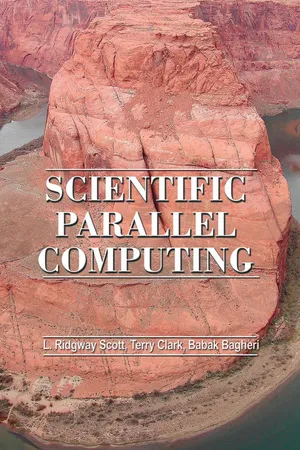
Scientific Parallel Computing
- 392 pages
- English
- PDF
- Available on iOS & Android
Scientific Parallel Computing
About this book
What does Google's management of billions of Web pages have in common with analysis of a genome with billions of nucleotides? Both apply methods that coordinate many processors to accomplish a single task. From mining genomes to the World Wide Web, from modeling financial markets to global weather patterns, parallel computing enables computations that would otherwise be impractical if not impossible with sequential approaches alone. Its fundamental role as an enabler of simulations and data analysis continues an advance in a wide range of application areas.
Scientific Parallel Computing is the first textbook to integrate all the fundamentals of parallel computing in a single volume while also providing a basis for a deeper understanding of the subject. Designed for graduate and advanced undergraduate courses in the sciences and in engineering, computer science, and mathematics, it focuses on the three key areas of algorithms, architecture, languages, and their crucial synthesis in performance.
The book's computational examples, whose math prerequisites are not beyond the level of advanced calculus, derive from a breadth of topics in scientific and engineering simulation and data analysis. The programming exercises presented early in the book are designed to bring students up to speed quickly, while the book later develops projects challenging enough to guide students toward research questions in the field. The new paradigm of cluster computing is fully addressed. A supporting web site provides access to all the codes and software mentioned in the book, and offers topical information on popular parallel computing systems.
- Integrates all the fundamentals of parallel computing essential for today's high-performance requirements
- Ideal for graduate and advanced undergraduate students in the sciences and in engineering, computer science, and mathematics
- Extensive programming and theoretical exercises enable students to write parallel codes quickly
- More challenging projects later in the book introduce research questions
- New paradigm of cluster computing fully addressed
- Supporting web site provides access to all the codes and software mentioned in the book
Frequently asked questions
- Essential is ideal for learners and professionals who enjoy exploring a wide range of subjects. Access the Essential Library with 800,000+ trusted titles and best-sellers across business, personal growth, and the humanities. Includes unlimited reading time and Standard Read Aloud voice.
- Complete: Perfect for advanced learners and researchers needing full, unrestricted access. Unlock 1.4M+ books across hundreds of subjects, including academic and specialized titles. The Complete Plan also includes advanced features like Premium Read Aloud and Research Assistant.
Please note we cannot support devices running on iOS 13 and Android 7 or earlier. Learn more about using the app.
Information
Table of contents
- Cover Page
- Title Page
- Copyright Page
- Dedication Page
- Contents
- Preface
- Notation
- Chapter 1. Introduction
- Chapter 2. Parallel Performance
- Chapter 3. Computer Architecture
- Chapter 4. Dependences
- Chapter 5. Parallel Languages
- Chapter 6. Collective Operations
- Chapter 7. Current Programming Standards
- Chapter 8. The IPlanguage Model
- Chapter 9. High Performance Fortran
- Chapter 10. Loop Tiling
- Chapter 11. Matrix Eigen Analysis
- Chapter 12. Linear Systems
- Chapter 13. Particle Dynamics
- Chapter 14. Mesh Methods
- Chapter 15. Sorting
- Bibliography
- Index